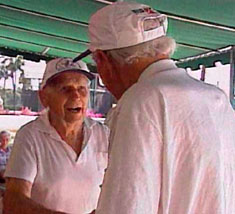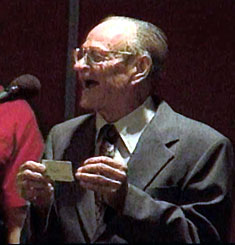Tennis in the Nineties
A Game for a Lifetime
by John Martin
Photos Courtesy of ABC News
Herman Ratcliffe was flustered. The wiry Georgian had just flown into
the Palm Springs Airport and discovered that his first-round match in the
USTA National Hard Court Championships was only two hours away. "I
guess I got it mixed up," he told a fellow passenger. "I thought
they wouldn't start till tomorrow."
Two hours later, Ratcliffe took the court in 90-degree heat. Three hours
after the match started, he won the final point in a three-set victory. He
pretended to race to the net so he could jump over, then veered off at the
final moment. The crowd roared with laughter - and relief.
Herman "Bubba" Ratcliffe of Hapeville, GA turned 90 this year.
The retired paper company shop foreman and manager was one of 11 entrants
in the USTA's 90-and-over championship at the Mission Hills Country Club.
Tournament Director Steve Solomon estimated there are about 90 players
across the country who play tournaments at age 90 or above.
The oldest competitor at Palm Springs, Ken Beer of Hillsborough, CA, is
96, a retired Pan Am pilot who flew to Europe, South America, Asia, and
was at the controls for the inaugural Boeing 4-motor seaplane flight
across the Pacific.

Ken Beer and Naylor Jones reminisce before their first round match.
|
Beer won the first national 90-plus championship last year. After
losing in the semifinal this year to Ratcliffe, he congratulated his
opponent, then sauntered off the court under his trademark straw cowboy
hat. "I've got some blind spots on my backhand," he told a
reporter. "I'm going to get some laser (eye) surgery to correct
it."
Nobody knows how much tennis can do to add years to the lives of
its players, but there are a lot of suspicions.
"It provides the necessary exercise I need," says Barry
Kusnick, 90, a retired engineer who worked on top-secret weapons projects
and wrote a best-selling book on sailing, The Boatmen's Bible (he lives
near Newport Beach). "I suspect it keeps me young."
"I hope I can play it until the day I pass on," says Naylor
Jones, 90, a retired power station operator from Los Angeles's San
Fernando Valley. He plays three days a week, bouncing the ball off the
frame of his racquet (with perfect muscle control and hand-eye
coordination) as he walks to the service line. "I love this
game," he says, sounding more like a television commercial for NBA
basketball.
Emil Johnson, 93, of Orlando, FL, calls himself "a health food
nut," who watches his diet carefully. An attendant at his assisted
care facility, where he lives alone, called Johnson "remarkable"
for his ability to stay active.

Emil Johnson, 93, is congratulated by his two great granddaughters
after winning the Championship
|
Johnson won the 2000 USTA Championship, defeating Ratcliffe in the Palm
Springs final. Seconds after the winning point (a crosscourt forehand that
whipped past his opponent), Johnson's two great granddaughters raced onto
the court to hug his knees (he is well over six feet tall).
It was a remarkable sight: A tall, smiling man in tennis whites wearing
a cap and Lawrence-of-Arabia-style cloak draped across his neck to shield
it from the sun, in a moment of pure triumph. Something Andre Agassi or
Pete Sampras might experience - in the year 2065.
A month later, Ratcliffe turned the tables and beat Johnson
in straight sets (6-2, 6-3) in the final of the USTA National 90 Indoor
Championships in Vancouver, WA.
Searching for scientific studies of tennis's beneficial effects on the
body can be almost as rewarding as looking for a flaw in Sampras's first
serve. The effect of dancing on toes and darting from side to side and
forward and back while striking a yellow sphere remains largely uncharted
by the National Institute for Aging.
Most of the literature sounds like scientists are studying droves of Pa
Kettles and Mother Theresas, rather than men and women athletically
vigorous in the tenth decade of their lives. (Beer hits 200 balls on a
ball machine each morning, then looks for a match).
A 1994 study in the New England Journal of Medicine ("Exercise
Training and Nutritional Supplementation for Physical Frailty in Very
Elderly People") found that Very Elderly People who carried on
high-intensity resistance exercise training were able to counteract muscle
weakness and physical frailty.
 |
 |
 |
 |
From left to right: Barry Kusnick, Ken Beer, Naylor
Jones, and Herman "Bubba" Ratcliffe
|
Pills alone won't do it, concluded the ten researchers: "Multinutrient
supplementation without concomitant exercise does not reduce muscle
weakness or physical frailty." Three years ago, researchers from
Harvard, Tufts, the Veterans Administration and a Hebrew Rehabilitation
Center for the aged in Massachusetts conducted "A Randomized
Controlled Trial of Progressive Resistance Training in Depressed
Elders."
Result: The exercise training reduced depression. The researchers
called it "an antidepressant...while also improving strength, morale,
and quality of life." But it wasn't tennis. Instead of scrambling for
drop shots, the elderly subjects (60 and older) worked on machines to
press legs and chests, extending and flexing knees.

Would developing a better backhand ease
depression? Ask Barry Kusnick.
|
Last year, a dozen psychiatrists, physicians, and psychologists from
Duke University, the University of Colorado, and the University of
California at San Diego conducted a similar study. "An exercise
training program," they wrote, "may be considered an alternative
to antidepressants for treatment of depression in older persons."
But what about developing a better backhand? Wouldn't that ease
depression? The world awaits those test results.
Meanwhile, 90-year-old tennis players continue competing, and, in some
cases, working: At 90, Harold Wiese of St. Louis is chairman of a major
truck distributorship in the Midwest. At 96, John Littley of Vancouver,
WA, still prunes his fruit orchards. Littley is a retired Alaska bush
pilot who worked as a welder and farmer. And Bob Lawrence, 90, of Santa
Barbara, ran his own photo imaging equipment company until just ten years
ago. Wiese and Littley sat out this year's tournament, but Lawrence
played, losing to Ratcliffe. Lawrence credits his wife, Myra, with getting
him started in tennis at age 69. "She gave me a wood racquet and I
started playing," he says. "I'm sort of competitive."
Tennis "keeps me alive," says Lawrence, explaining that it's
a matter of "getting the exercise, having something to do."
And just how much can a 90-year-old do? Remember that Bubba Ratcliffe
stepped off the plane and played three sets in 90-degree heat. Afterward, he sat down for an interview with ABC

Bubba's poem stole the show
|
News, chatting about his love of
tennis: "I like the competition, I like the people, I like their
wives," he said, cracking a devilish grin. But that wasn't the end of
his day. After our 30-minute interview, Bubba changed into a smart business suit and tie, attended
players' dinner, and danced with the
wives of younger players competing in a USTA 60-and-over tournament.
Then, he stole the show. When the music stopped, he walked to the
stage, pulled out a piece of paper, and recited a poem:
"I get up in the morning and dust off my wits,
"Pick up the paper and read the obits.
"If my name is missing, I know I'm not dead,
"So I eat a big breakfast, and go back to bed."
Not very likely.
 John
Martin, an ABC News National Correspondent, is the founder and editor of
Aztec Tennis Reporter, a worldwide newsletter for the San Diego
State tennis community. John
Martin, an ABC News National Correspondent, is the founder and editor of
Aztec Tennis Reporter, a worldwide newsletter for the San Diego
State tennis community.
To receive the Aztec Tennis Reporter, write to John Martin, 1528
Corcoran St., NW, Washington, D.C. 20009.
Copyright 2000, John Martin
Your comments are welcome. Let us know what you about think
John Martin's article by emailing
us here at TennisONE.
|